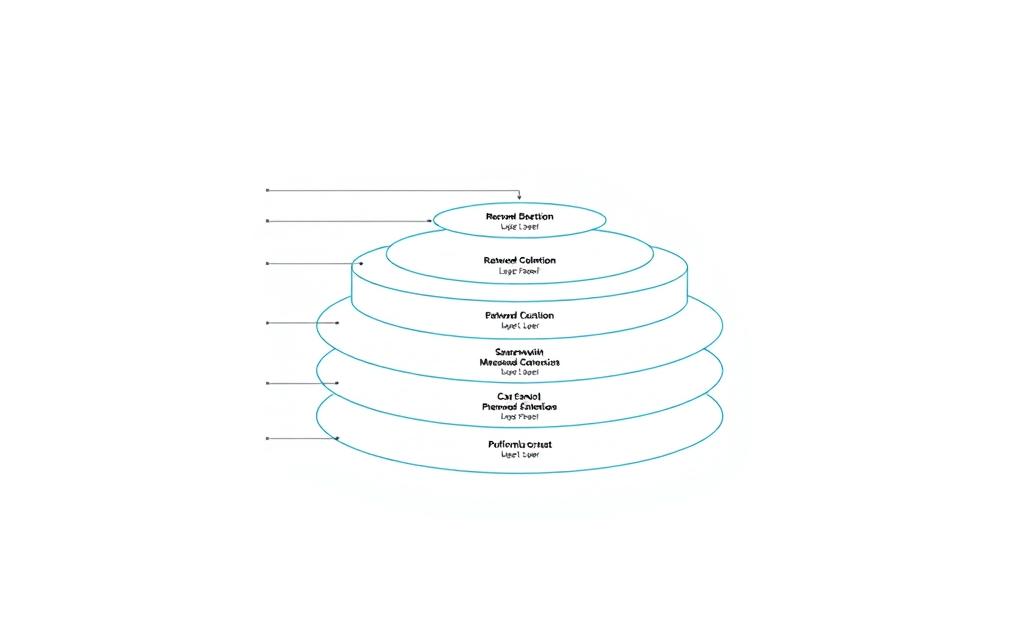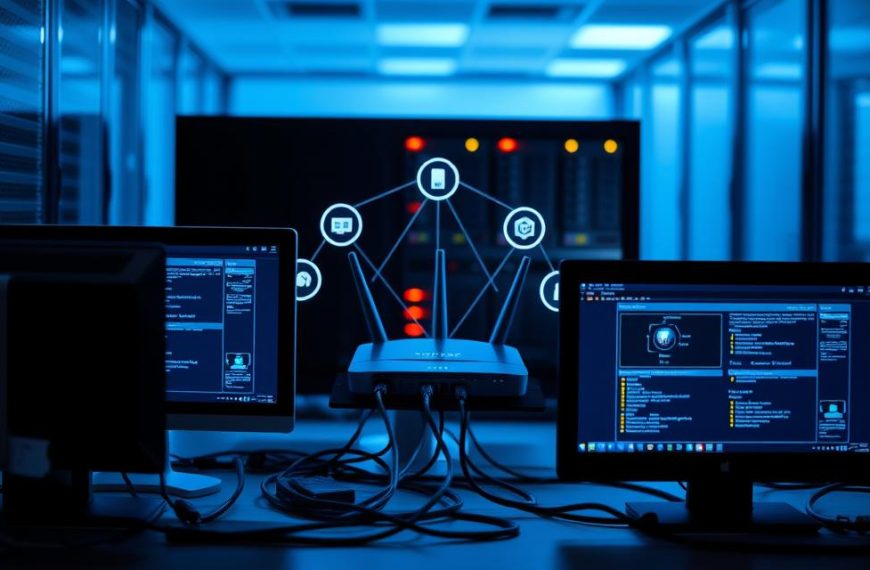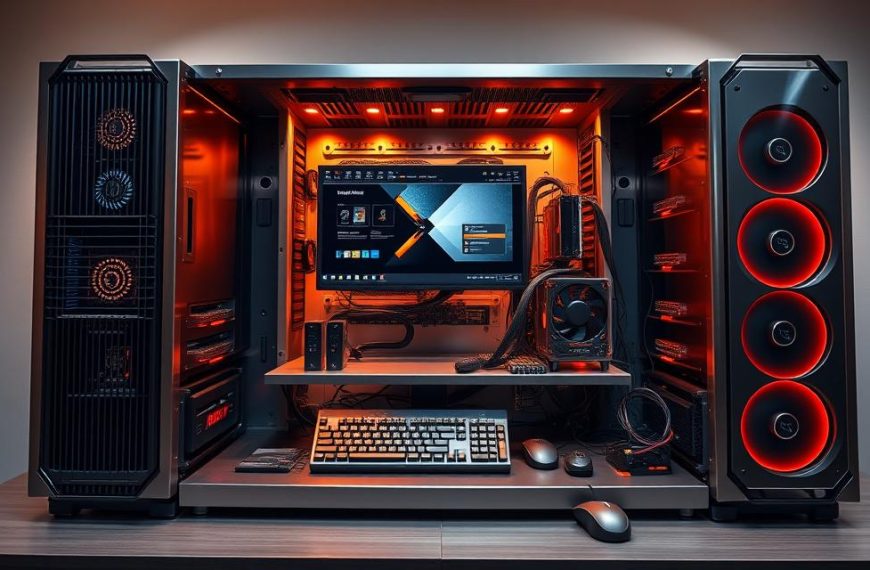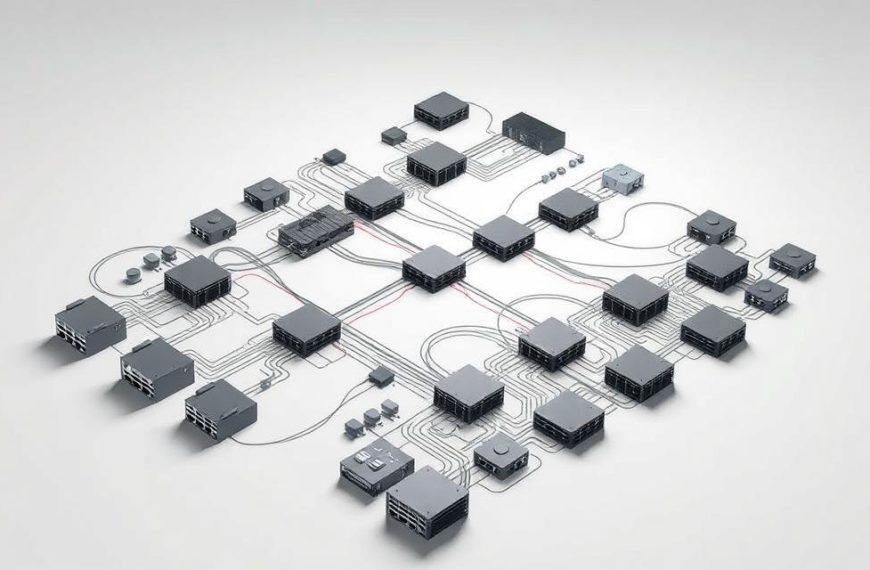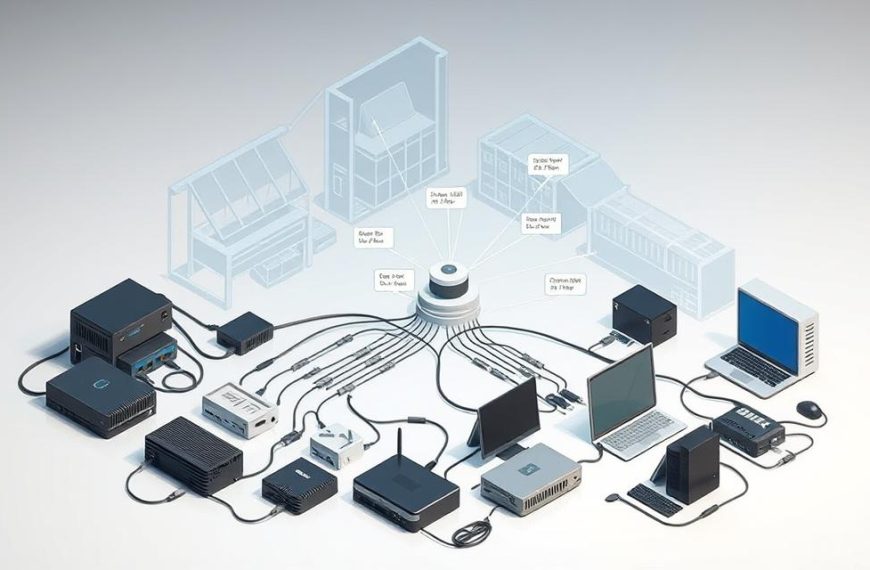Modern computer networking needs standard frameworks for different systems to talk to each other. The OSI (Open Systems Interconnection) Model is this key blueprint for data communication across networks.
The International Organisation for Standardisation (ISO) created this framework. It organises network communication into seven layers. Each layer has its own job, from making physical connections to handling application data.
This layered network architecture makes complex device interactions simpler. It lets different technologies work together smoothly. It also makes it easier to find and fix problems.
The OSI model is key for understanding how data moves across networks. Its structured way of doing things still shapes modern networking protocols and system designs.
Understanding Reference Models in Networking
Network communication is complex, involving many components and systems. To handle this, the networking world uses structured frameworks called reference models. These blueprints guide the design, implementation, and troubleshooting of network systems.
Definition and Purpose of a Reference Model
A reference model is an abstract framework that sets a common base for network communication standards. It describes ideal architectures for development, without giving exact solutions.
The main goal of reference models is to create a universal language for networking. The International Organization for Standardization explains the OSI model’s role:
“Provides a common basis for the coordination of standards development for the purpose of systems interconnection.”
This standardisation helps different manufacturers and developers make compatible products. Reference models use a layered approach to clearly define networking functions.
Benefits of Using Reference Models
Reference models bring many advantages for network designers, administrators, and users. They make complex networking concepts easier to manage and organise.
Enhanced troubleshooting capabilities are a key benefit. Reference models help technicians pinpoint problems to specific layers. This focused approach saves time and improves efficiency.
These models also speed up research and development. Experts can focus on individual layers, without needing to know the whole network stack. This division of labour encourages innovation and keeps systems compatible.
The flexible standardisation of these models is also noteworthy. Networks can add new technologies without needing a complete overhaul. This adaptability ensures networks stay relevant and reduces the risk of becoming outdated.
| Benefit Category | Technical Impact | Business Value |
|---|---|---|
| Standardisation | Creates uniform development guidelines | Reduces compatibility issues |
| Interoperability | Enables multi-vendor integration | Lowers implementation costs |
| Troubleshooting | Isolates layer-specific issues | Minimises network downtime |
| Innovation | Allows specialised layer development | Accelerates technology adoption |
These benefits make networks more robust, efficient, and future-proof. The structured approach of reference models shapes modern networking practices worldwide.
What is a Reference Model in Computer Network
The OSI model is a key framework, but many other models use similar ideas to organise network communications. These models share key traits that help us understand complex networks.
Key Characteristics of Reference Models
Reference models have a few key features that make them useful. The most important is their layered architecture. Each layer does specific tasks for the layer above and gets help from the layer below. This makes the network stack easy to manage.
Another key point is abstraction. Higher layers hide the details of lower layers. This lets developers focus on their layer without needing to know too much about others. It makes designing and building networks simpler.
Network protocols are also crucial. They help different network devices talk to each other. These protocols set rules for data exchange, making sure different systems work together well.
Examples Beyond OSI
The TCP/IP model is a big alternative to OSI. It’s the base of the modern Internet. It was made with help from the U.S. Department of Defence and is outlined in RFC 1122 and RFC 1123.
TCP/IP was made for real-world use, not just theory like OSI. It was developed at the same time as OSI but focused more on internet needs.
Other examples include IBM’s Systems Network Architecture (SNA) and Digital Equipment Corporation’s DECnet. These were made to help with networking within specific companies.
Each model shows how reference models fit different needs while keeping the core ideas of layered design and standardised protocols.
The OSI Reference Model: An Overview
The OSI Reference Model is a key concept in networking. It’s not used in today’s internet protocols but changed how we talk about networks. Its layered structure has made a big impact.
History and Development of the OSI Model
The OSI model started in the early 1970s. Back then, networks were mostly separate systems. They were either government projects or owned by companies.
Hubert Zimmermann, a French engineer, first outlined the OSI model in 1978. His work was in Washington, D.C. It aimed to make networks talk to each other.
In 1980, the International Organization for Standardisation (ISO) made it official. They called it ISO 7498. This made OSI a standard for connecting systems.
Several things pushed for the OSI model:
- Networks from different companies couldn’t talk to each other.
- Government and research networks needed to work together.
- Network experts needed a common language.
Importance in Modern Networking
Even though TCP/IP is the base of the internet, OSI is still important. Its layers help us understand complex networks better.
The OSI model is great for finding problems in networks. It helps technicians focus on one layer at a time. This makes fixing network issues faster.
Schools all over the world teach the OSI model. It helps students learn about networking basics. The seven-layer model makes it easy to see how data moves and how protocols work together.
| Aspect | Historical Context | Modern Application |
|---|---|---|
| Primary Purpose | Standardisation between disparate systems | Conceptual understanding and education |
| Implementation | Intended as universal standard | Used alongside TCP/IP for analysis |
| Industry Value | Interoperability between vendors | Troubleshooting and protocol development |
| Educational Role | New framework for network discussion | Foundation for networking curricula |
Even today, companies and developers use OSI layers when making new products. This ensures their products work well together and follow clear standards.
The OSI model’s lasting impact shows how a good idea can keep changing things for decades. It still guides how we tackle and talk about network problems today.
The Seven Layers of the OSI Model
The OSI model has seven layers that help us understand how networks work. Each layer does a specific job and talks to the next one through clear rules. This makes sure networks can talk to each other in a standard way.
Layer 1: Physical Layer
The physical layer is the base of network communication. It deals with sending raw bits over physical media.
Functions and Responsibilities
This layer looks after the electrical, mechanical, and procedural parts of connections. It sets up voltage levels, timing, and data rates. It also decides on connector types. It makes sure bits are sent reliably between devices.
Examples and Technologies
Technologies like Ethernet cables, fibre optics, and wireless signals are used here. Devices like hubs, repeaters, and network interface cards work at this level. Protocols such as RS-232, DSL, and wireless standards are also used.
Layer 2: Data Link Layer
The data link layer helps with data transfer between devices. It checks for errors and makes sure data is sent right.
Functions and Responsibilities
This layer puts bits into frames and uses MAC addresses for addressing. It checks for errors and controls how much data is sent. It also manages who gets to use the network.
Examples and Technologies
Ethernet is a common technology here. Other examples include PPP, HDLC, and Frame Relay. Devices like switches and bridges work at this layer, using MAC addresses to forward frames.
Layer 3: Network Layer
The network layer helps packets get from one network to another. It uses logical addresses and routing to do this.
Functions and Responsibilities
This layer uses IP addresses for addressing. It finds the best path for packets using routing algorithms. It also breaks up packets if they’re too big.
Examples and Technologies
IP is the main protocol here. Routing protocols like OSPF, BGP, and RIP also work at this level. Routers are key devices that operate at this layer.
Layer 4: Transport Layer
The transport layer makes sure data is delivered completely. It provides reliable services to upper layers.
Functions and Responsibilities
This layer handles breaking data into segments, controlling flow, and fixing errors. It offers either reliable or unreliable communication. It ensures data is delivered by using acknowledgments.
Examples and Technologies
TCP provides reliable communication, while UDP is for fast, unreliable services. Other protocols include SCTP and DCCP. They manage communication between applications.
Layer 5: Session Layer
The session layer manages conversations between applications. It sets up, keeps, and ends sessions.
Functions and Responsibilities
This layer handles authentication, authorization, and restoring sessions. It controls communication, whether it’s half-duplex or full-duplex. It also synchronizes data exchange.
Examples and Technologies
Protocols like NetBIOS, PPTP, and RPC work here. They manage setting up and keeping sessions. The session layer ensures data is sent in the right order.
Layer 6: Presentation Layer
The presentation layer deals with data representation and formatting. It makes sure data is understood by different systems.
Functions and Responsibilities
This layer translates, encrypts, and compresses data. It changes data into a format for the network and back. It makes sure data is compatible across different platforms.
Examples and Technologies
SSL/TLS provides encryption at this layer. Data compression formats like JPEG and MPEG also work here. Character encoding standards like ASCII and Unicode are used too.
Layer 7: Application Layer
The application layer talks directly to user applications. It provides network services to programs.
Functions and Responsibilities
This layer identifies who is talking and if resources are available. It synchronizes communication and checks data integrity. It supports user applications directly.
Examples and Technologies
Protocols like HTTP, FTP, SMTP, and DNS operate here. They enable services like web browsing and email. The application layer is the link between network services and user applications.
| Layer Number | Layer Name | Primary Function | Protocol Data Unit | Key Protocols |
|---|---|---|---|---|
| 7 | Application | User interface and application services | Data | HTTP, FTP, SMTP |
| 6 | Presentation | Data translation and encryption | Data | SSL, TLS, JPEG |
| 5 | Session | Session establishment and management | Data | NetBIOS, RPC |
| 4 | Transport | End-to-end communication | Segment/Datagram | TCP, UDP |
| 3 | Network | Logical addressing and routing | Packet | IP, ICMP |
| 2 | Data Link | Physical addressing and error detection | Frame | Ethernet, PPP |
| 1 | Physical | Raw bit transmission | Bit | RS-232, DSL |
OSI Model vs TCP/IP Model
The OSI model is a detailed theory, but the TCP/IP suite is what makes the internet work. Knowing both helps us understand how networks are designed and how they work.
Key Differences and Similarities
The main difference is where they came from and how they’re structured. The TCP/IP model, also known as the DoD model, was made by the US Department of Defense. It was created for military use before the OSI model.
TCP/IP has a simpler structure:
- It combines OSI’s Application, Presentation, and Session layers into one layer.
- It merges OSI’s Data Link and Physical layers into a single Network Access Layer.
- It keeps OSI’s Transport and Internet layers separate.
TCP/IP is a functional solution based on specific protocols like TCP and IP. The OSI model, on the other hand, is a theoretical framework for all network communication, without focusing on specific protocols.
Even with their differences, both models share key similarities:
- They use a layered architecture for networking.
- They separate concerns between layers clearly.
- They have standardised interfaces between layers.
- They help us understand data flow.
Practical Applications and Usage
In the real world, the TCP/IP suite is the backbone of the internet architecture. It’s what makes the internet work, with every device using its protocols to communicate.
The OSI model is not used in full but is vital in education and troubleshooting. Network experts use its seven layers to:
- Find and fix network problems.
- Explain complex networking ideas.
- Compare different networking technologies.
- Design new network protocols and systems.
For those interested in comparing protocols, both models offer valuable insights. TCP/IP shows how the internet works, while OSI explains why networks are designed the way they are.
This knowledge helps network engineers work well with real systems and think clearly about new ideas and problems in complex networks.
Conclusion
The OSI reference model is key to understanding network architecture. It has seven layers that show how data moves in communication systems. This model is crucial for learning about networks in school and work.
Even though the TCP/IP model is used in practice, the OSI model is vital. It provides a common language for networking professionals. This makes it easier to talk about complex network issues and design systems.
The OSI model is still very important in the networking world. It helps us see how data flows and how protocols work together. Its structured way of looking at networks is still useful, even with new technologies.
